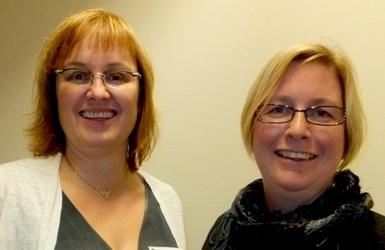“Entrepreneurship has been viewed as a male social practice, based on factors such as high technology, growth, risk and innovation, which are regarded as masculine. In many ways the statistics confirm this, since only 26 percent of Norwegian business owners are women,” says Associate Professor Gry Agnete Alsos.
She and Senior Researcher Elisabet Ljunggren recently took part in a national conference where they presented their work that will be included in an anthology on gender and the business sector. Alsos and Ljunggren are two of the anthology’s editors and have worked for many years with the topic of gender and entrepreneurship.
They are trying to find some of the reasons that the gender difference exists and endures.
“We take our point of departure in anthropologist Jorun Solheim’s argument which concludes that capitalism is gendered. Capitalistic societies are structured along gender lines, and they clearly distinguish between family and employment and the private and public spheres,” says Alsos.
Capitalistic behaviour and entrepreneurship can be regarded as cultural phenomena with cultural meaning and value.
“We support sociologist Amanda Brickman Elam’s theory that gendered cultural capital can help to explain the gender differences in entrepreneurship.”
Cultural capital
Elam bases her theory on the French sociologist Pierre Bourdieu’s concept of cultural capital. Cultural capital refers to non-financial social assets, usually related to knowledge or intellect, which can help to enhance a person’s social mobility.
Elam asserts that this is a useful concept in the discussion about gender differences in business ownership. She distinguishes between dispositional and institutional cultural capital.
“Dispositional cultural capital is the traditional, historically based cultural capital which has been dominated by men. This type of capital can be defined as ways of thinking that are developed over a long period of time in various areas of society. It has to do with our perspectives on how the world is put together and how these influence our tastes, preferences and expectations about how the world works. In contrast, institutional cultural capital is shaped by education and employment, and can thus be a mean of overcoming inequality. Possession of institutional cultural capital has given women access to spheres that traditionally have been dominated by men,” says Alsos.
She and Ljunggren believe that differences in dispositional and institutional cultural capital are one reason that women and men choose different paths to entrepreneurship.

Tradition versus education
The researchers’ preliminary analyses show that female business owners generally have fewer owner shares, that fewer women than men are sole proprietors, and that women are often majority owners of smaller companies but have minority ownership in larger companies.
“If we look at dispositional cultural capital, which entails traditional ways of thinking, we see that there is a low percentage of female entrepreneurs and business owners in traditionally male-dominated industries, whereas the percentage is high in female-dominated sectors. With regard to institutional cultural capital, there is a low percentage of female entrepreneurs and business owners in industries with many male employees and male-dominated educational programmes, whereas the percentage is high in industries with many female employees and female-dominated educational programmes,” explains Alsos.
Gender segregated ownership
“Women have the lowest percentage of ownership in the construction industry, the goods transport industry and electrical installation. We find the largest percentage of female owners in the health and beauty industry, pre-schools and clothing sales,” Ljunggren adds.
She and Alsos have categorized the business sector into the skilled trades, commercialized work performed in the home, the modern high-tech industry, and self-employed certified professionals.
“The skilled trades include plumbing, electrical installation and construction, and these have traditionally been a male arena. Childcare and hair styling are examples of commercialized work performed in the home, which traditionally have been dominated by women. Both of these are based in traditional ways of thinking,” explains Ljunggren.
See also: Women conquer private business
High-tech versus self-employed certified professionals
According to Ljunggren, the modern high-tech industry, such as ICT services, is strongly linked to the masculine, stereotypical definition of entrepreneurship with its focus on factors such as growth, risk and innovation. This does not, however, apply to self-employed certified professionals in fields such as accounting and dentistry which require a high level of education and professional certification.
“Professions such as accounting and dentistry are more accessible to women because they achieve legitimacy through education. Both professions in the modern high-tech industry and the certified professions are based on institutional capital, but while self-employed certified professionals acquire this kind of capital through education, it’s not always obvious how this occurs in the high-tech sector,” says Ljunggren.
What is needed?
“‘Everyone’ knows what is required to become a lawyer – but what is really needed to become a founder of a high-tech company? There are many paths to the goal, including education and experience. We believe that when in the certified professions such as dentistry it is clear how to achieve the institutional capital required, it is also easier to change gender inequalities. This is the case for both the individual woman and man, and not least for those who want to achieve political change,” says Alsos.

“Although there is not a clear correlation between becoming a dentist through education and running one’s own dental practice, the correlation is nonetheless direct enough that we can assume that more women will own dental practices if more of them study to become dentists. It might help if more women became engineers and acquired work experience in high-tech companies, but the correlation between this and starting and owning this type of business is somewhat more complicated,” Alsos continues.
A difficult road
“It is difficult to correct the gender differences in entrepreneurship by implementing short-term political measures, since the differences based on traditional ways of thinking have longstanding historical roots,” says Ljunggren.
She believes that education and work experience can help to counteract these differences, but she says it is a challenge because traditional ways of thinking influence a person’s choice of education.
As long as people’s choices of education and profession continue to be as traditional and divided along gender lines as they are in Norway, the potential for education to challenge traditional gender differences will remain untapped.
Symptom relief
Ljunggren believes that the masculine definition of entrepreneurship hampers change, while at the same time less gender segregation in working life in general does not mean there will be fewer gender differences in entrepreneurship.
“Even if working life had a more balanced gender mix among employed engineers and dentists, this would not necessarily have an impact on the gender mix with regard to business start-ups and ownership in the relevant sectors. We know that there are large differences in gender balance among various branches and these differences are even greater when it comes to business start-ups,” says Alsos.
“One of the major challenges is that measures for increasing female entrepreneurship only relieve the symptoms without actually changing the fundamental gender imbalance in society,” Ljunggren adds.
Inadequate measures
The researchers argue that profound structural and cultural factors are instrumental in creating the gender inequalities in entrepreneurship. In addition to cultural capital, this also entails structural factors such as an unequal distribution of capital and income between women and men in society.
“The measures being implemented do not address these problems, and instead usually involve training, network-building or modest funding for female entrepreneurs. Emphasis has also been placed on the effect of role models. This might be helpful to some women who receive assistance, but the investment does not correspond in either size or form to the fundamental problem – or to the target of 40 percent female entrepreneurs. As a result, it is completely unrealistic that these measures can make any substantial difference in the number of female entrepreneurs or in the inequalities in the branches we have talked about – at least in the foreseeable future,” the researchers conclude.
Translated by Connie Stultz.
Gry Agnete Alsos is an associate professor at the Bodø Graduate School of Business, University of Nordland.
Elisabet Ljunggren is a senior researcher at Nordland Research Institute.
Pierre Bourdieu (1930-2002) was a French sociologist and anthropologist who was known for developing the concepts of symbolic, social and cultural capital, as well as the concept of habitus.



